Hiking has a lot of physical and mental benefits for you. Research has shown that hiking can help with anxiety and severe depression. Another study also shows that hiking can reduce the risk of cancer, cardiovascular disease, and diabetes. It improves your cardio fitness as your heart will have to work harder when you go on a hike.
Dogs can be a great companion for outdoor activities, and there are 10 breeds we recommend that can join you on your outdoor adventures and keep up with your pace. While all the dogs on this list are large, there are also small size dogs that can be a great hiking partner.
Here are the top 10 most adventurous dog breeds for hiking, mountain climbing, backpacking, and camping!
Read More:
1. Labrador Retriever
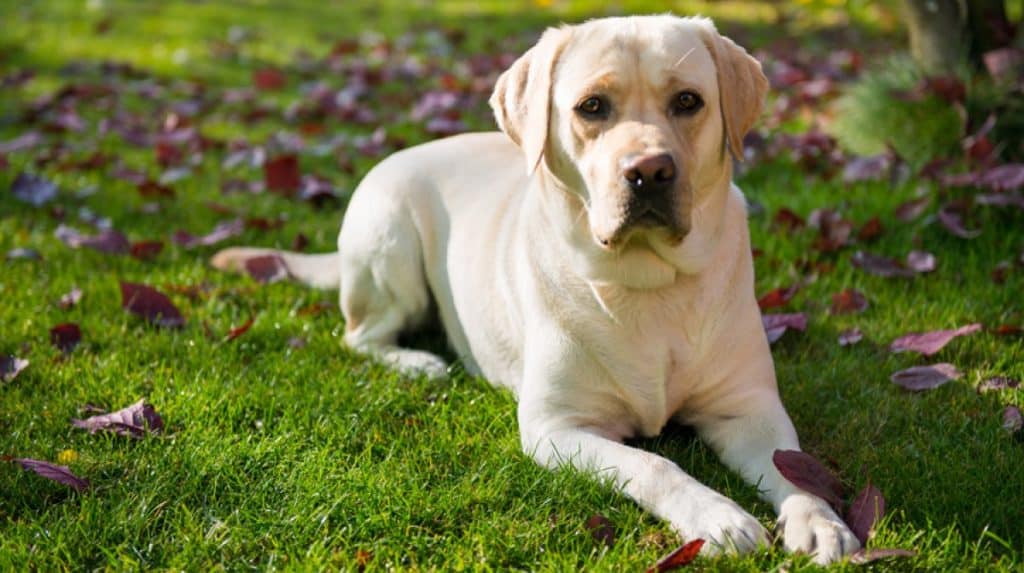
Lab originated from Newfoundland, a northern province of Canada, back in the 1500s. Labs are medium to large breeds owned by fishermen and used as working dogs to help catch and retrieve fish. Their water repellent coat and webbed paws made them great for these jobs. They come in 3 colors, yellow, black and chocolate.
Labs are known for their loyalty, friendly and outgoing. This beautiful dog is America’s most popular family breeds that always want your attention. They love cuddling and bonding with your family. What makes them a great outdoor companion is that they are strong, muscular, energetic, and require a large amount of exercise every day. They love to run, catch, and can be a great swimmer.
2. Australian Shepherd
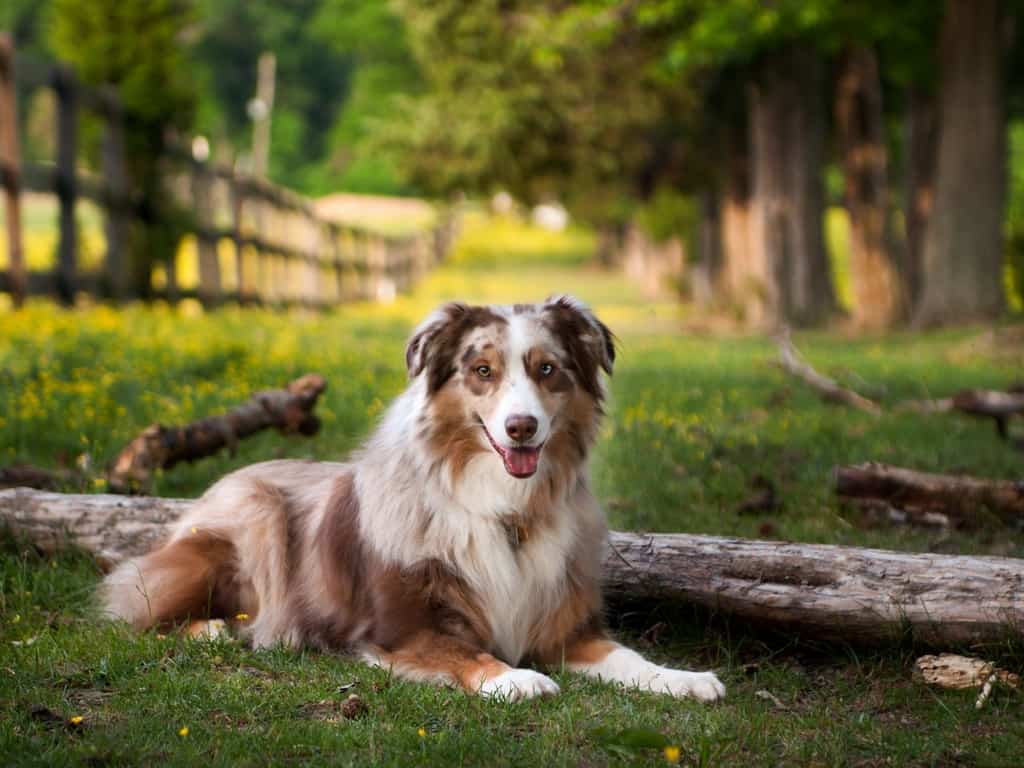
Australian Shepherd, a medium-size herding dog also known as “Aussies”. You might be thinking their origin is Australia due to its name. Surprisingly, they originated from the Western United States. Disney has made a movie for Aussies called “Stub” and has since risen its popularity. Typically weigh from 35 to 70 pounds, live around 12 to 15 years, and have various color combinations.
With Aussies’ intelligent, hyperactive, and energetic temperament, you will need to keep them occupied. They are eager and are great at dog sports like dog agility. They require daily outdoor activities such as walking, running, and Frisbee games. Their strong work drive makes Aussies one of the best dogs for hiking.
3. Border Collie
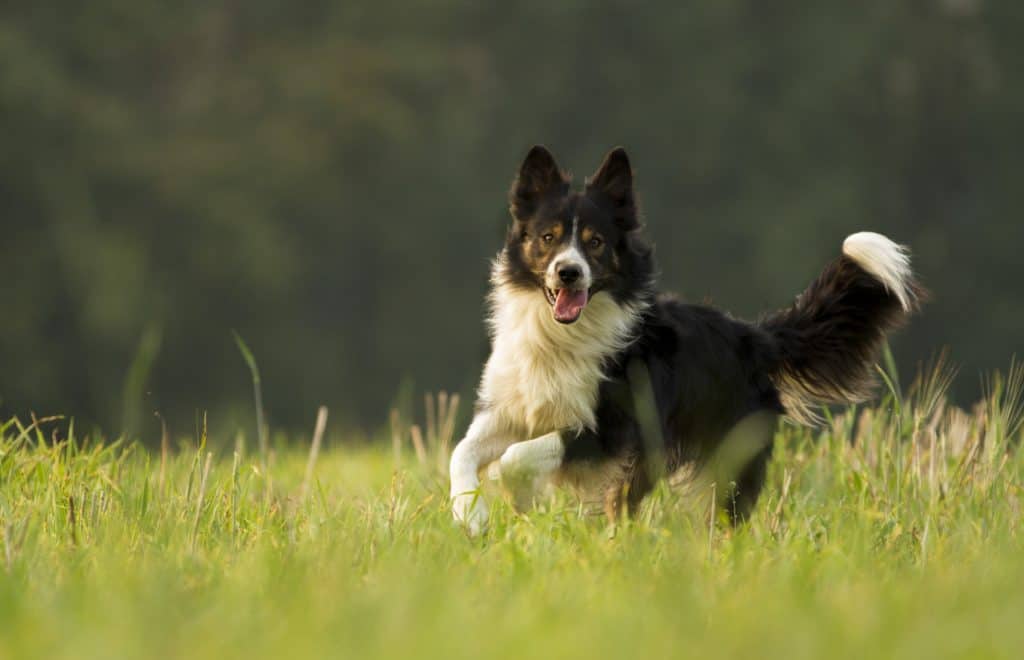
The smooth or rough double-coated dog, Border Collie, also known as “Scottish Sheepdog,” is a medium-sized breed that originated from England and Scotland’s border. They were used to herd sheep in the past and considered one of the best herding breeds. They have become popular after winning multiple official sheepdog trials in the 19th century.
They have endless stamina, and with their working heritage, it makes them perfect at outdoor activities. They are extremely intelligent, athletic, and playful, which they can run all day. If you love challenging hikes, mountaineering, and rappel down a cliff, Border Collie will be your best buddy.
4. Siberian Husky
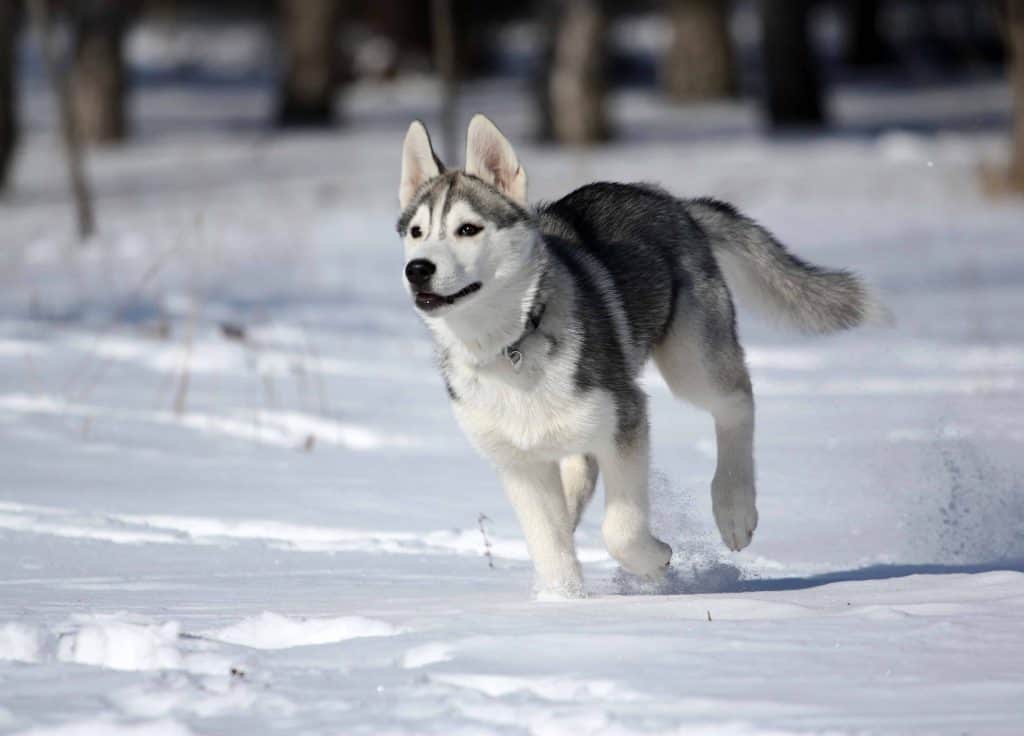
Siberian Husky is a medium-sized breed and a member of the Spitz genetic family. They were developed by the Chukchi, indigenous people who inhabited eastern Siberia, a province in Russia. They were used as dog sleds for transports and were then brought to Alaska for sled dog racing. These wolf-like breeds weigh between 35 to 60 pounds and have a lifespan of 12 to 15 years.
Siberian Husky loves digging, jumping over fences, chewing everything like their harness or leash, and often being described as an “escape artist”. They are athletes, independent, and love outdoor adventures. Make sure you take them out to explore the wild. Their thick furry double coat has made them a great companion in the cold.
5. German Shorthaired Pointer
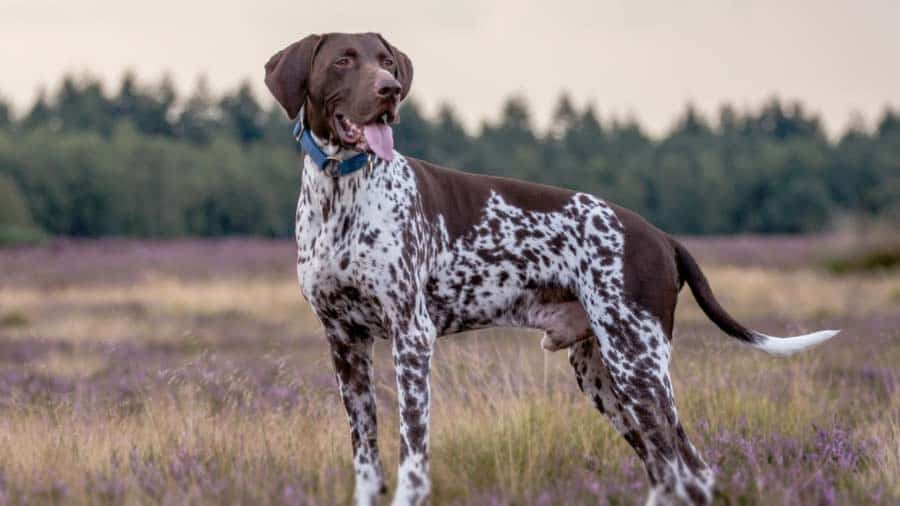
The medium to large-sized breed, German Shorthaired Pointer, is a German breed used to hunt in the past. It was believed that they were developed by crossbreeding a few times until the 1860s to have the most desirable hunting breed in terms of agility and pointing instinct. They typically weigh between 45 to 70 pounds and live around 12 to 15 years.
German Shorthaired Pointer is agile, affectionate, and easy to train dogs. They possess a high energy level, which requires lots of exercise every day. Without having enough daily outdoor activities, they will become anxious and destructive. Their nature has made them a perfect hiking partner.
6. Alaskan Malamute
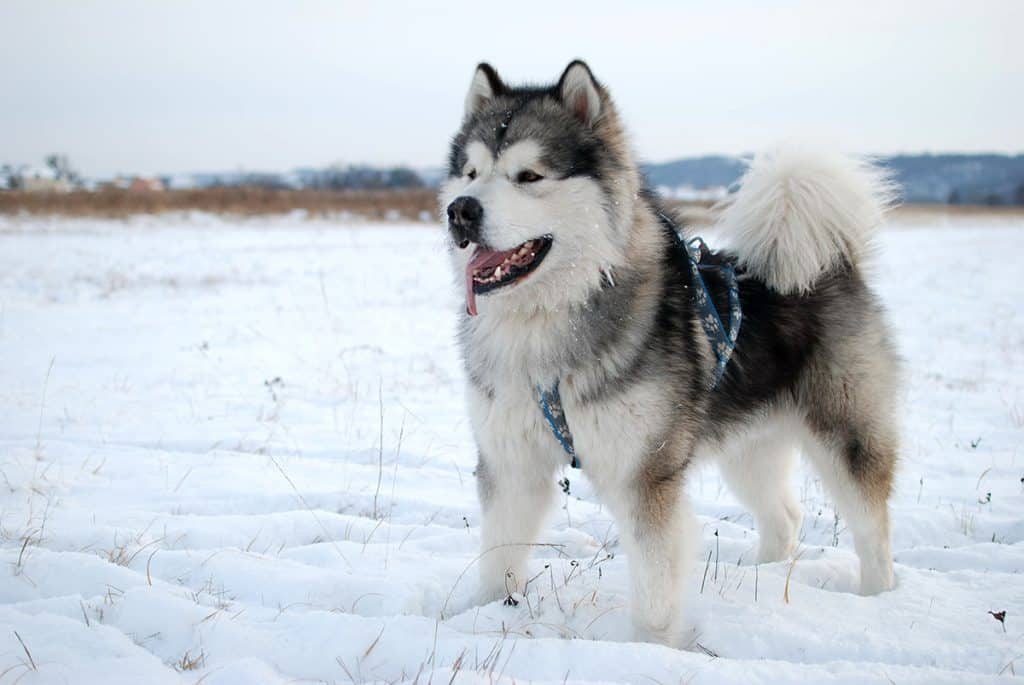
Alaskan Malamute is a large breed and one of the oldest sled dogs. They were sometimes called “Mal” or “Mally” and look like the famous Siberian Husky. Traceback to their origin, Mals originated from Alaska and used to hunt big game by the native people about 2000 to 3000 years ago. They were then used to haul heavy freight during the gold rush due to their strength and endurance.
Alaskan Malamutes are powerful dogs and can tolerate freezing temperatures because of their origin and thick double coat. This magnificent dog is affectionate and loyal. They also love their families, just like the history in which they would share food with the people and help keep the babies warm. If you like hiking in the cold, this breed will be ideal for you.
7. Bernese Mountain Dog
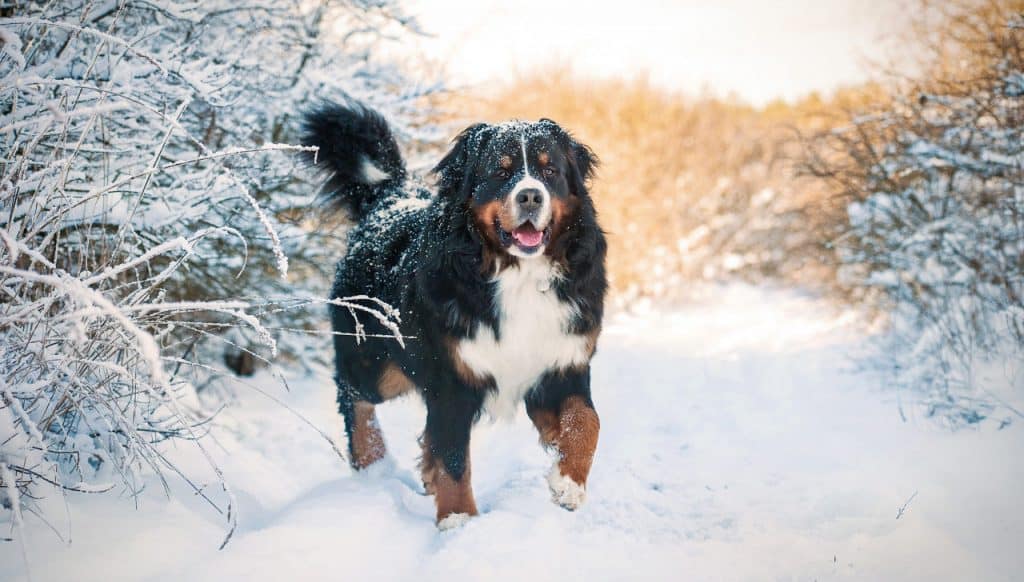
Like any other working dogs, Bernese Mountain Dogs were used to pull carts, herd cattle, and guard farms from more than 2000 years ago. There are four types of Swiss mountain dogs with the same markings. Berner is one of them and is distinguished by its thicker and longer coat. They typically weigh between 70 to 120 pounds, and sadly, they are considered as one of the shortest life breeds with an average lifespan of 6 to 8 years.
Berners are cheerful, alert, and loyal, and they are happy-go-lucky kind of dogs. They are strong, muscular, and love to go on outdoor adventures. And Berner will be your best friend if you live in a colder place, as their thick and long coats are designed to withstand freezing temperatures. Keep in mind that they may be uncomfortable if you take them out in hot weather for too long.
8. Vizsla
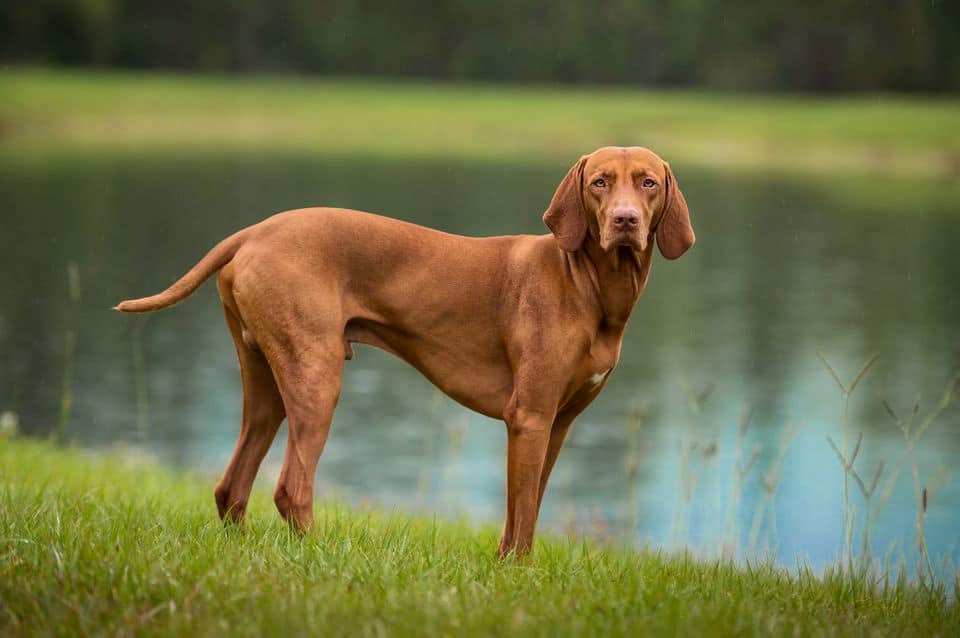
This breed can be traced back to more than 1000 years ago. They are sometimes called “Magyar Vizsla” or “Hungarian Hunter” originated from Hungary. In the past, they were used as pointer dogs. They would stop and aim their muzzles towards the quarry and retrieve it back to the hunter. However, they have a very heartbroken history which they were near extinction several times, especially during World War II.
People often refer to Vizsla as the “Velcro Dog” as they love to stay with the family all day. They are energetic, gentle, and hardworking. Vizsla is also a top contender in dog sports, which means they have a lot of energy to offer when it comes to extended hikes. If you are an active hiker, this athlete will definitely suit you due to their high energy level.
9. Rhodesian Ridgeback
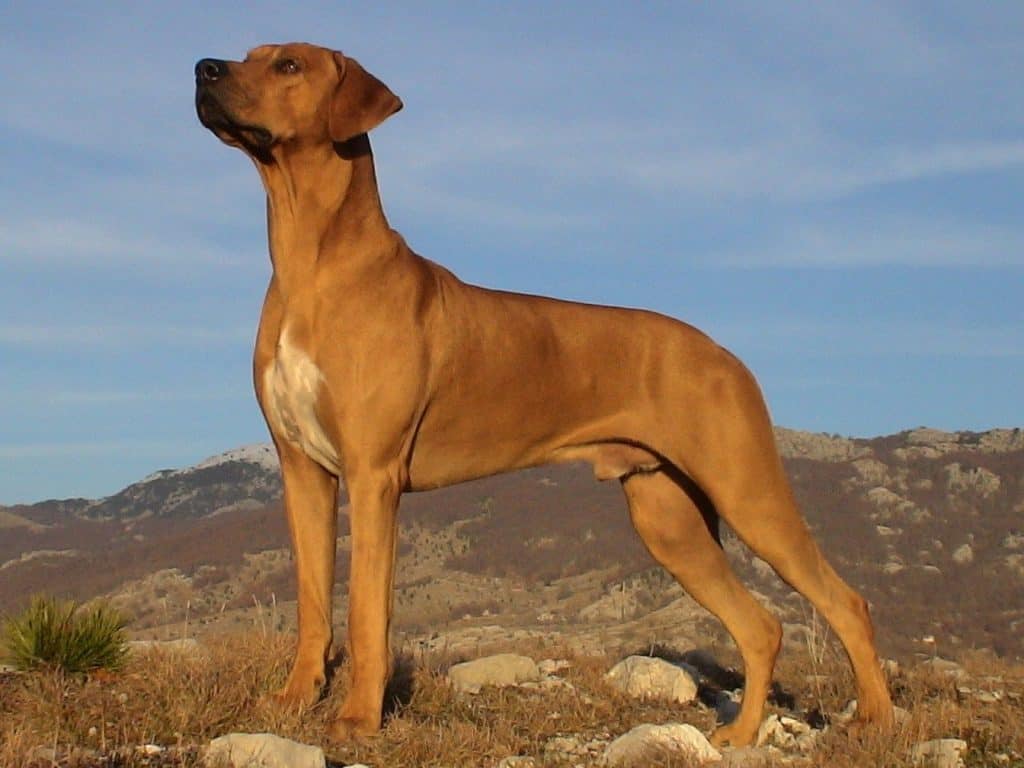
Rhodesian Ridgeback was bred in Southern Africa to track and hunt big game. They were developed by mixing the native hunting breeds with European breeds such as Mastiff, Greyhound, and Bloodhound. They were also known as “African Lion Dog” not because they can take down lions, but due to their capability of cornering the lion in place while waiting for the hunter’s arrival.
Rhodesian Ridgeback is powerful, agile, and highly alert. Because of these temperaments they possess, Ridgebacks are also used as guard dogs. They love to be with people and enjoy being outside. This breed has a high tolerance to hot and cold weather, making them a great partner for outdoor activities.
10. German Shepherd
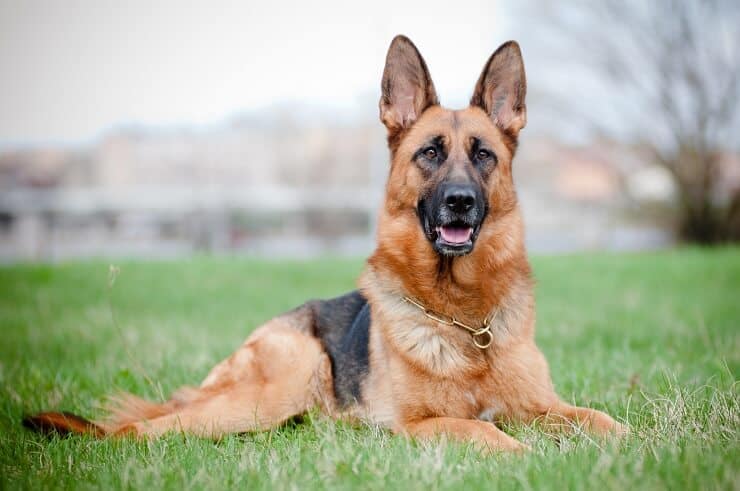
As its name implies, the German Shepherd originated from Germany in the 1800s, is a medium to a large-sized working dog. They are known as “Alsatians” and were originally owned by farmers used to herd sheep and protect the flocks from predators. They weigh between 48 to 88 pounds and have a life expectancy of 9 to 13 years. They were widely used as police dogs to track criminals due to their courageous and superb sense of smell.
German Shepherd is one of the most intelligent, obedient, and very easy to train dogs. They are also highly active, which requires daily exercises and training. Like Australian Shepherd, they are eager to learn, love to play, and want to have a purpose. Their unique characteristics have made them a great hiking friend and protector.
You May Also Like: How Much Does A German Shepherd Cost?
Benefits of Hiking with Your Canine
1. It is safer
It wasn’t really 100% safe if you plan to stay overnight by yourself. But hitting the trail with your four-legged hiking companion can ensure your safety, as dogs are always alert and very protective of their owners, especially those we’ve mentioned on this list, with one exception (*cough* Labs *cough*).
2. Helps relieve stress
Without any doubt, getting out of town, leaving busy city life behind, and immersing yourself in nature with your furry hiking companion can surely help relieve stress. As you inhale, the fresh air will increase the amount of serotonin (your happy hormone), and the more fresh air you get, the happier you are.
3. Keep you and your adventurous pup fit and healthy
Also, hiking is great exercise. Not only can it keep you and your canine fit, but like most cardio exercises, hiking can also reduce your risk of having heart disease, stroke, high blood pressure, high cholesterol, and even some cancers.
4. Prevent unwanted behavior in dogs
Working 9 to 5 from Monday to Friday and hanging out with family and friends on the weekends means less time spent together with your pup. Without some quality bonding time together, your dog is very likely to become anxious, aggressive, and develop undesirable behavior. One way you can prevent that is to exercise them. For instance, go hiking together, go on a backpacking trip, or camping to provide them the stimulation they need.

What Qualities Make A Dog Breed A Great Trail Partner
While many dogs can hike, some can make a better hiking buddy than others, particularly if they possess the following traits.
1. Athleticism
Though most dogs indeed like to go for walks every day, that doesn’t necessarily mean they are suitable for hikes on uneven terrain and in high altitudes for hours. Flat-faced, short-nosed dogs like Bulldogs and Pugs have breathing problems, which intense exercise like hiking can be dangerous for them as they might not be able to get enough oxygen.
2. Appropriate Age
Dogs who are too young also not suitable for hiking as their joints are still developing, plus they have a weaker immune system. Older dogs aren’t a good hiking partner either as they tend to have joint issues and many other problems. So, at what age can you bring your dog on hikes? Most dogs should wait until they are at least one year old before they can join you on your adventure!
3. Climate-Appropriate Hair Length
Breeds with longer hair are more resilient to cold, while dogs with short coats can tolerate heat better. And you obviously don’t want to bring, say, a Greyhound, to go on a winter hike. So make sure to keep the climate you usually hike in in mind before you adopt a dog.
4. Confident and Calm
Think about the things you may encounter on the trail, the squirrels, native wildlife, flower scents, and people. And you would be better off bringing dogs who can positively interact with everything they see, as hiking with canines who treat everything as a threat can be a real challenge.
5. Obedience level
Dogs who are smart, easy to train, and would listen to their owners very reliably are the best companion for hiking like Labrador Retrievers, as you don’t want your pup to stray off the trail and get themselves into trouble.
Gear You Should Also Bring for Hiking with Your Trekking Companion
Loose rocks, gravels, and steep inclines and descents can put your furry friend in danger. So they have to be very well equipped. And apart from their food and treats, below are the things you may also need to bring along on your hiking trip.
1. Leashes
One thing you will certainly need is your dog’s leash to help secure your pup and prevent them from running into dangerous situations. While you can use a traditional lead, you may want to consider leashes attached to your waist instead. That way, you will be able to keep your hands free and make your journey more enjoyable.
2. Harnesses
And of course, you will also need to bring a dog harness specially designed for this activity. You would want something durable and reliable enough to keep your four-legged friend in control. Need recommendations? Check out our list of the best dog harnesses for hiking!
3. Doggie Hiking Packs
There are many items and essentials you need to bring as well. Your keys, phone, food, first aid kit, and whatnot. So why not consider a doggie saddlebag to let your furkid carry their food, treats, and water rather than using a dog hiking harness.
4. Winter Coats
You may also need to get a winter jacket for your dog to protect them from the cold temperature if you plan to hit the trail in winter, especially if you have a short-haired dog breed that doesn’t do well in cold weather.
5. Dog Booties
Hiking barefoot on uneven, rough surfaces can increase your dog’s risk for injury. So it’s also a good idea to get them doggie booties to provide them traction and protect their pads from rocks, splinter, twigs, and other sharp objects.
6. Water Bottles
Never let your pup drink out of rivers, creeks, ponds, and streams as the water source may be dirty and contain toxins or bacteria, which can be dangerous to dogs. So, make sure to bring a water bottle to provide your dog with clean water.
7. Camping Tents
If you also plan to camp overnight, you will need a camping tent. Though many tents can do the job, some tents are more suitable for camping with dogs. Also, you can bring a comfortable dog bed to secure your canine a good night’s rest.
8. Other Gear You Should Also Consider
The list can go on and on. However, there are two more devices you should consider bringing as well. A GPS dog collar tracker to ensure your pooch won’t get lost in the wilderness and a tick remover tool to prevent blood-sucking parasites from passing unwanted diseases to your dog.
What Else Do You Need to Know for Hiking with Your Dog
It is great to have a strong and fit partner that can go on a trail with you side by side. The ten hiking dogs recommended in the above should give you an idea of which breed best suits your personality. But regardless of which breed you choose, there are a few things you need to know before heading out. And below are some of them. Need more tips? You can find it here!
1. Check the Weather
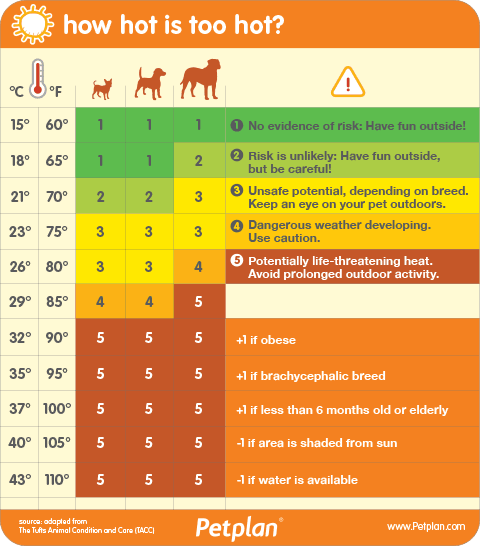 Always check the weather before you hit the trail. You would want to make sure that your dog can withstand the weather, not too hot or too cold so that your four-footed friend can enjoy the hike as much as possible.
Always check the weather before you hit the trail. You would want to make sure that your dog can withstand the weather, not too hot or too cold so that your four-footed friend can enjoy the hike as much as possible.
If you plan to hike with them in cold weather, be sure to check on them constantly to see if they are too cold and get them a sweater or coat if needed. Generally, you don’t want to take your dog out at 25°F or below unless you have breeds like Siberian Huskies, Alaskan Malamutes, and Bernese Mountain Dogs as they have high cold tolerance and love to be in the snow!
And you would also want to avoid going out when the temperature is at 80°F. That said, every breed is different. Some were developed to have high heat tolerance, like Vizslas. Just make sure to observe your dog for signs of heatstroke when hiking in the warmer months.
2. Is Your Dog Fit Enough?
You would also need to make sure your dog has enough stamina to handle the trail. And always consult with your veterinarian to ensure that your dog has no medical concerns and is healthy enough to go hiking.
3. Research the Trail Beforehand
Check to see if the trail is dog-friendly, and you would want to know things like the type of the trail (loop or out-and-back), how difficult it is, the distance, as well as the elevation gain so that your dog doesn’t have to end up perching on your back.
Recommended Reads:

